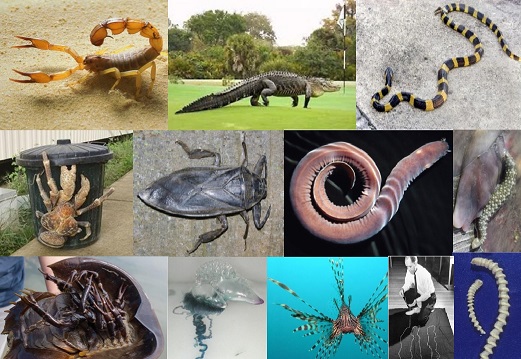Nightmares in a Bell-Jar Further Information

Everyone has a different idea of a nightmare – but each one of these is likely to give some people a restless night!
Are you brave enough to find out more?
Yellow Fat-tailed Scorpion
Widespread in North Africa and the Middle East, this is one of the world’s most dangerous scorpions, with an aggressive nature and venom which is one of the most potent neurotoxins of any scorpion.
The sting causes fever, increased heart rate and blood pressure, convulsions, coma, or increased fluid secretions to the lungs, and can result in death if a person is small, ill or allergic.
American Alligator
The alligator is a large reptile endemic to the southern United States. Ours is a very young alligator, but an adult can grow to as much as 4.5 metres long and easily kill a human.
Although they do not naturally regard people as prey, the close proximity of humans to their habitat means that each year, a number of deaths by alligator attack are recorded in the United States.
Banded Krait
Native to India, China and Malaysia, but has been recorded in Borneo, Java and Sumatra.
The banded krait has a venom that is very toxic. They can grow up to 2 metres long, but the bite from even a very small one delivers a neurotoxin capable of causing death to a human.
Coconut Robber Crab
Found on islands from the Indian Ocean to the central Pacific – these aggressive and nocturnal scavengers are known for their ability to climb tall palm trees in search of coconuts which they later crack open with their massive claws.
They have been known to eat small mammals and birds. They are fully adapted to life on land and will actually drown if submerged in water.
Giant Water Bug
The largest of the true bugs, giant water bugs are sometimes called ‘toe-biters’ because they can inflict a terribly painful bite on anyone who is resting their feet in the water.
They inject digestive juices into their prey - usually small fish or crustaceans - then suck up the resulting slurry. They live in North and South America and East Asia.
Hagfish
Hagfish belong to the group of primitive, jawless fish which includes the marine and freshwater lampreys. Its razor sharp teeth allow it to burrow into the body of a fish -dead or alive - and eat it from the inside out. Whilst eating, they can tie their tail into a knot to generate torque and increase the force of their bite.
Hagfish Day is the 3rd Wednesday of October – every year!
Horseshoe Crab
The Horseshoe Crab, also known as the King Crab, lives on the sea floor in warm coastal waters. It is not really a crab - but an arachnid - more closely related to spiders and scorpions. They can grow up to 60cm long, and have light-blue copper-based blood.
Viewed from underneath they have a disturbing similarity to the Facehugger in the Alien films.
Parasitic Worms
Skate Leech Marine leech found most commonly on fish from the skate family, hence its common name, skate-sucker.
Pentastomida Worm-like parasites typically found in the respiratory tract of reptiles, mammals and birds. Snakes are a common host, so humans can be infected through eating contaminated bush meat or handling infected snakes.
Portuguese Man O’ War
Commonly thought of as a jellyfish, this is actually a colonial organism made up of animals closely related to jellyfish.
Its venomous tentacles can grow up to 50 metres in length and have a very painful sting which leaves red welts on the skin for days, and has been known to be fatal to humans.
They are increasingly being spotted in UK waters.
Scorpion Fish / Lion Fish
This fish has two common names which liken it to other animals – both of which are a danger to humans – a hint that their spines are extremely poisonous, delivering a sting that can cause extreme pain, sweating, respiratory distress and even paralysis.
They live in coral reefs in the Indian and Pacific Oceans.
Sea Urchin
The Cidaroida is a primitive order of sea urchins which is the only living order remaining of its class. All other orders of this subclass became extinct over 66 million years ago.
They are strange and beautiful, but be careful because the spines can cause a nasty injury.
Tapeworm
This is a type of flat, segmented, parasitic worm still common in some parts of the world, which lives in the digestive tract of animals and humans. Infection is caused by ingesting the eggs or larvae in infected food or water, usually raw or undercooked pork, beef or fish.
They can live in a host for years and grow up to 15 metres long. In the early 1900s ‘sanitised tapeworms’ were available to buy as an ill-advised method of weight loss.